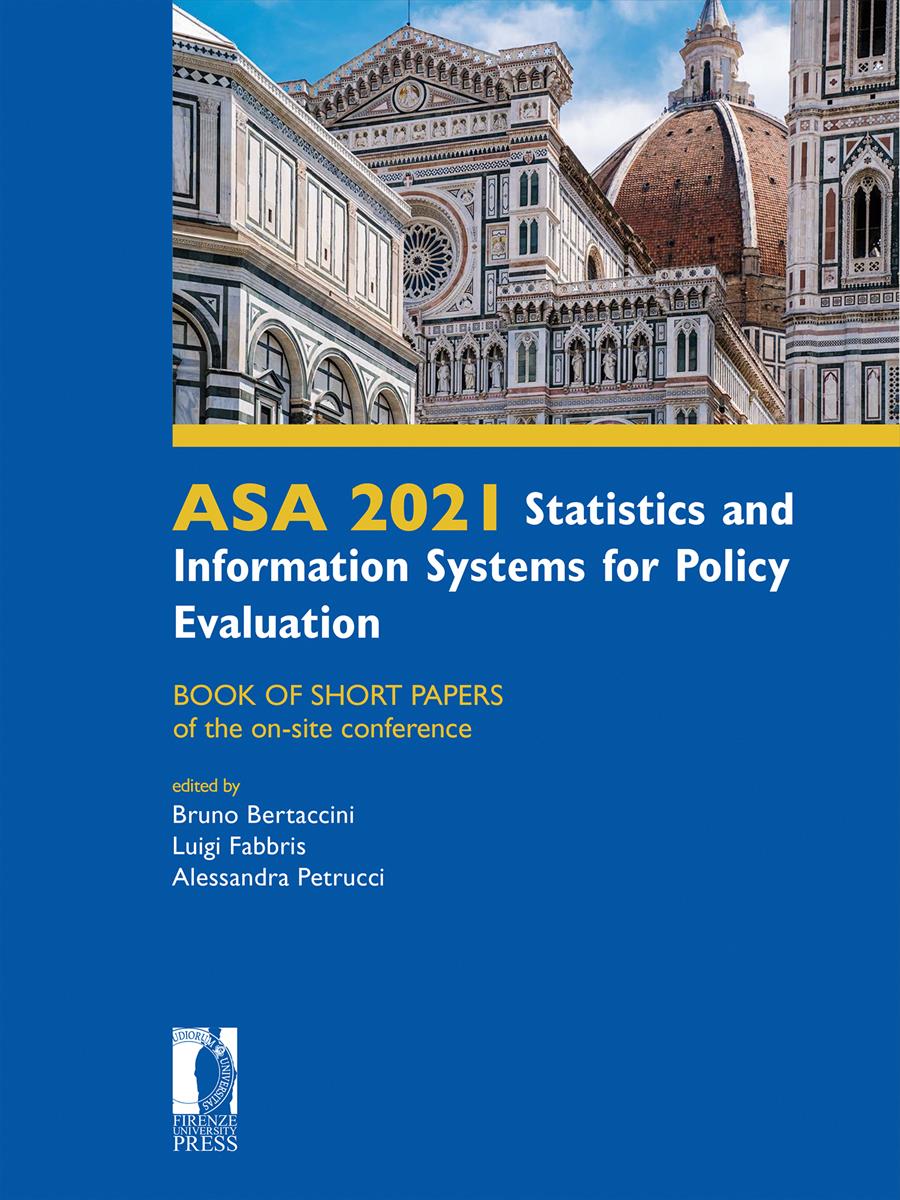- ASA 2021 Statistics and Information Systems for Policy Evaluation
- Edited by Bruno Bertaccini, Luigi Fabbris, Alessandra Petrucci
Understanding the sensory characteristics of edible insects to promote entomophagy: A projective sensory experience among consumers
- Alfonso Piscitelli
- Roberto Fasanelli
- Elena Cuomo
- Ida Galli
- © 2021 Author(s) |
- CC BY 4.0
- DOI: 10.36253/978-88-5518-461-8.42
In recent years, a remarkable number of studies have investigated sensory characteristics, such as flavor and texture, of edible insect and insect-based foods, their contribution to consumers’ attitudes toward edible insects are important in consumer appeal and their willingness to try eating insects in the future. This paper addresses the problem of describing the sensory characteristics aof edible insect and insect-based foods in terms of preferences. To this end, we conducted a study to explore the representations of sensory experiences related to an insect-based dish involving a voluntary sample of 154 consumers. The quasi-experiment, which we have called projective sensory experience (PSE), follows a two-step procedure. In the first step, we asked the participants to imagine tasting an insect-based dish and then to rate, from 1 (imperceptible) up to 10 (very perceptible), the following taste-olfactory sensations: Sapidity, Bitter tendency, Acidity, Sweet, Spiciness, Aroma, Greasiness-Unctuosity, Succulence, Sweet, Fatness, Persistence. In the second step, we asked our interviewees to indicate, through a specific check-list, which was the most disturbing and least disturbing taste-olfactory sensation imagined. We collected data from May to July 2020 by using an anonymous on-line questionnaire. Results could help understand the sensory characteristics of “insects as food” that should be used or avoided, for example, in communication aimed at promoting familiarity with edible insects and improving the acceptability of insects as a novel food.
- Keywords:
- Edible insect,
- Projective sensory experience,
- Consumers’ preference,
- Entomophagy,
University of Naples Federico II, Italy - ORCID: 0000-0001-6638-2759
University of Naples Federico II, Italy - ORCID: 0000-0001-8908-3284
University of Naples Federico II, Italy - ORCID: 0000-0001-7526-2353
University of Naples Federico II, Italy - ORCID: 0000-0001-5159-9162
- Agresti, A. (2002). Categorical Data Analysis, 2nd edition. Wiley, Hoboken, (NJ).
- Amato, M., Fasanelli, R. and Riverso, R. (2019). Emotional Profiling for Segmenting Consumers: The Case of Household Food Waste. Calitatea, 20(S2), pp. 27–32.
- Bilder, C.R., Loughin, T.M. (2014). Analysis of Categorical Data with R. CRC Press, Boca Raton, (FL).
- Donadini, G., Spigno, G., Fumi, M.D., Pastori, R. (2008). Evaluation of Ideal Everyday Italian Food and Beer Pairings with Regular Consumers and Food and Beverage Experts. Journal of the Institute of Brewing, 114(4), pp. 329-342.
- La Barbera, F., Verneau, F., Videbæk, P.N., Amato, M. and Grunert, K.G. (2020). A self-report measure of attitudes toward the eating of insects: Construction and validation of the Entomophagy Attitude Questionnaire. Food Quality and Preference, 79(103757), pp. 1–9.
- La Barbera, F., Verneau, F., Amato, M. and Grunert, K. (2018). Understanding Westerners’ disgust for the eating of insects: The role of food neophobia and implicit associations. Food Quality and Preference, 64, pp. 120–125.
- Lammers, P., Ullmann, L.M., and Fiebelkorn, F. (2019). Acceptance of insects as food in Germany: Is it about sensation seeking, sustainability consciousness, or food disgust?. Food Quality and Preference, 77, pp. 78–88.
- Mancini, S., Moruzzo, R., Riccioli, F., and Paci, G. (2019). European consumers' readiness to adopt insects as food. A review. Food Research International, 122, pp. 661–678.
- Materia, V.C. and Cavallo, C. (2015). Insetti per l’alimentazione umana: Barriere e drivers per l’accettazione da parte dei consumatori. Italian Review of Agricultural Economics, 70(2), pp. 139–161.
- R Core Team (2021). R: A Language and Environment for Statistical Computing. R Foundation for Statistical Computing, Vienna, (AT). Available at: http:/www.R-project.org (accessed 15 June 2021).
- Schrögel, P. and Wätjen, W. (2019). Insects for Food and Feed-Safety Aspects Related to Mycotoxins and Metals. Foods, 8(8), pp. 288–315.
- Sogari, G. and Vantomme, P. (2014). A Tavola con Gli Insetti. Mattioli 1885, Fidenza, (IT).
- Sogari, G., Menozzi, D., and Mora, C. (2017). Exploring young foodies ׳†knowledge and attitude regarding entomophagy: A qualitative study in Italy. International Journal of Gastronomy and Food Science, 7, pp. 16–19.
- Verneau, F., La Barbera, F., Kolle, S., Amato, M., Del Giudice, T., Grunert, K. (2016). The effect of communication and implicit associations on consuming insects: An experiment in Denmark and Italy. Appetite, 106, pp. 30–36.
Chapter Information
Chapter Title
Understanding the sensory characteristics of edible insects to promote entomophagy: A projective sensory experience among consumers
Authors
Alfonso Piscitelli, Roberto Fasanelli, Elena Cuomo, Ida Galli
Language
English
DOI
10.36253/978-88-5518-461-8.42
Peer Reviewed
Publication Year
2021
Copyright Information
© 2021 Author(s)
Content License
Metadata License
Bibliographic Information
Book Title
ASA 2021 Statistics and Information Systems for Policy Evaluation
Book Subtitle
BOOK OF SHORT PAPERS of the on-site conference
Editors
Bruno Bertaccini, Luigi Fabbris, Alessandra Petrucci
Peer Reviewed
Publication Year
2021
Copyright Information
© 2021 Author(s)
Content License
Metadata License
Publisher Name
Firenze University Press
DOI
10.36253/978-88-5518-461-8
eISBN (pdf)
978-88-5518-461-8
eISBN (xml)
978-88-5518-462-5
Series Title
Proceedings e report
Series ISSN
2704-601X
Series E-ISSN
2704-5846
